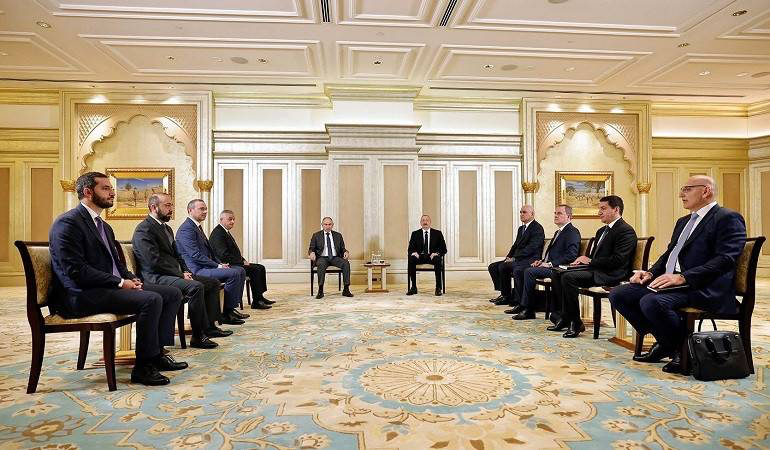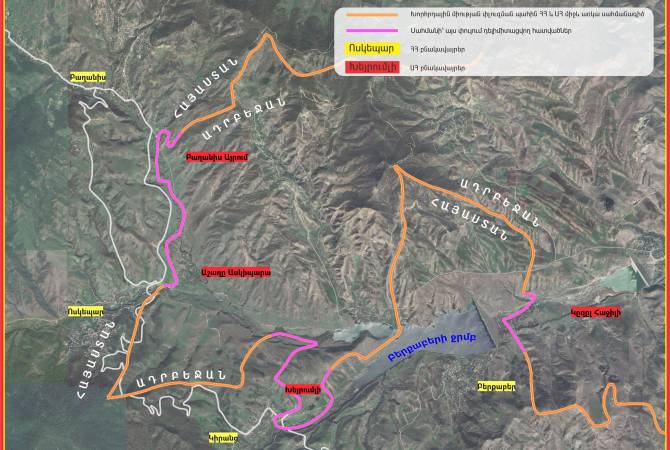Armenian and Azerbaijani border delimitation chairs cross border in historic first

On 5 September, the chairs of Armenian and Azerbaijani border delimitation committees, Mher Grigoryan and Shahin Mustafayev, held unprecedented mutual visits to each other’s respective countries.
According to Armenia’s Foreign Ministry, the parties discussed border delimitation and demining efforts on their shared border. They also discussed the restoration and construction of ‘necessary infrastructure’ and their implementation.
This was the first confirmed meeting between Grigoryan and Mustafayev following the Washington summit on 8 August between Armenia, Azerbaijan, and the US, which saw the initialling of the peace treaty, as well as agreement to establish a route between Azerbaijan and its exclave of Nakhchivan through Armenia called the Trump Route for International Peace and Prosperity (TRIPP).
It remains unclear where the meeting took place. However, on 5 September, unconfirmed reports suggested that, ‘five days’ earlier, residents of Kapan in the Syunik region had noticed individuals in Azerbaijani military uniforms driving four unlicensed vehicles, reportedly bearing the word ‘Turk’ on white backgrounds, into the city centre. They reportedly left the city that same evening.
A change in the delimitation course following agreement on TRIPP?
The border delimitation commissions of the two countries were created in 2022. Previously, they met in various other venues such as Moscow and Brussels, following which they held recent meetings on their shared border.
Ahead of the September meeting, on 10 July, commission chairs Grigoryan and Mustafayev were present during the meeting of Armenian and Azerbaijani delegations led by Armenian Prime Minister Nikol Pashinyan and Azerbaijani President Ilham Aliyev in Abu Dhabi.

According to the Armenian Foreign Ministry readout, the leaders, ‘taking stock of the progress made with respect to the border delimitation process, instructed the respective state commissions to continue practical work in this regard’.
Earlier in winter, two meetings were held — one on 16 January at the border, where they ‘agreed on starting the complex of works on the delimitation of the state border from the northern section’ — from the intersection bordering Armenia, Azerbaijan, and Georgia. ‘And [the second one was] in the southern direction, from North to South: to the border of’ Armenia, Azerbaijan, and Iran.
Tigran Grigoryan, a political analyst and head of the Regional Centre for Democracy and Security in Yerevan, suggested Armenia and Azerbaijan might change the next demarcation location, considering the agreement on the Trump Route, which will pass through Syunik.
However, he told RFE/RL that it was ‘unlikely’ that Azerbaijan would agree on delimitation in areas it gained after the Second Nagorno-Karabakh War as a result of its attacks on Armenia.
The most tangible outcome of the works of the border delimitation committees was the border delimitation in the north — Tasvush and Ghazakh section in the spring of 2024.

The process came shortly after Baku demanded that four abandoned Azerbaijani villages under Armenian control be ‘immediately released’. Days later, Pashinyan hinted that Armenia might return control of the four villages to Azerbaijan in a unilateral handover of territory to avoid war.
Following the dissolution of the Soviet Union and the outbreak of the First Nagorno-Karabakh War in the early 1990s, several areas along the border of both Armenia and Azerbaijan fell under the control of the opposing side. This included the Azerbaijani villages of Baghanis Ayrym, Ashagi Eskipara, Kheyrimli, and Gizilhajili, which remained occupied by Armenia.

Turkish special envoy to arrive Yerevan
Armenian authorities reported that a meeting between special representatives for the Armenia–Turkey normalisation process, Ruben Rubinyan and Serdar Kılıç, will hold a meeting in Armenia ‘in the coming days’.
The meetings of the special representatives kicked off in January 2022, taking place in various capitals, such as Moscow and Vienna. While Armenia and Turkey have reached an agreement to allow third-country citizens and diplomats to cross the border between the two countries, the Armenia–Turkey land border remains closed, with Turkey conditioning progress with the Armenia–Azerbaijan peace process.
Previously, in July 2024, Rubinyan and Kılıç held their fifth meeting on the Margara–Alican crossing on the border of the two countries. While in April, they met within the framework of the Antalya Diplomacy Forum.











